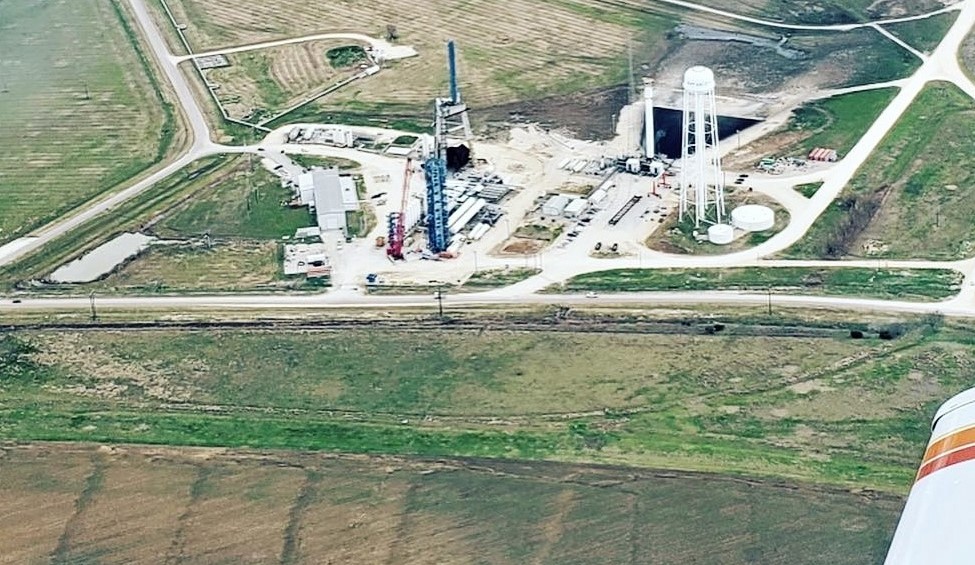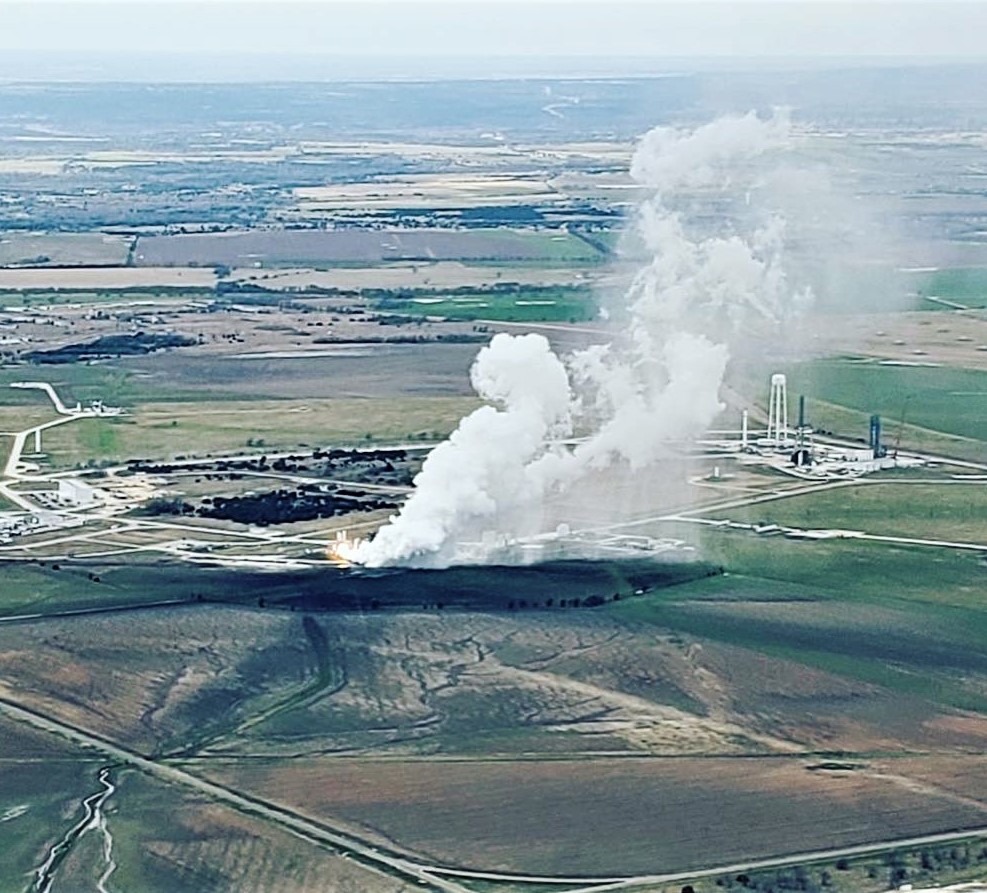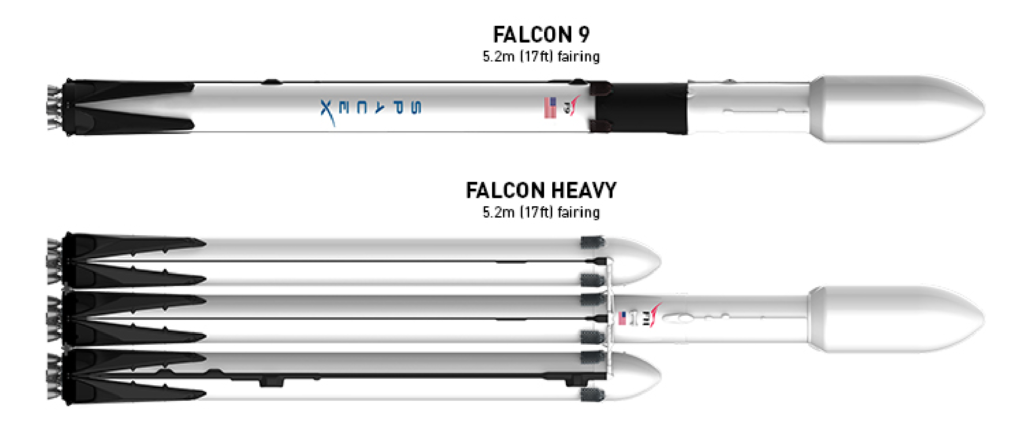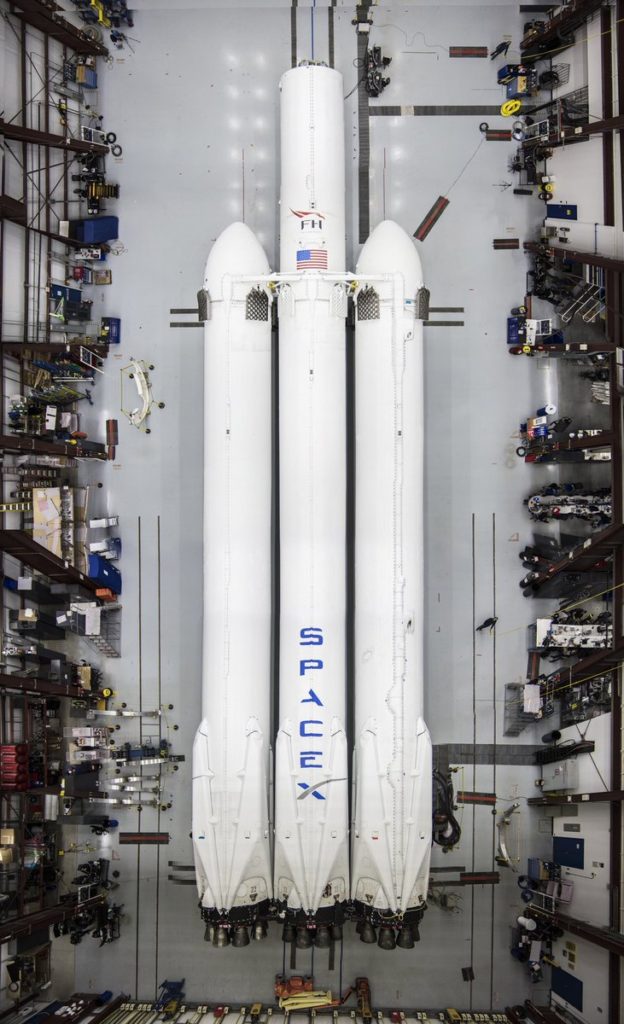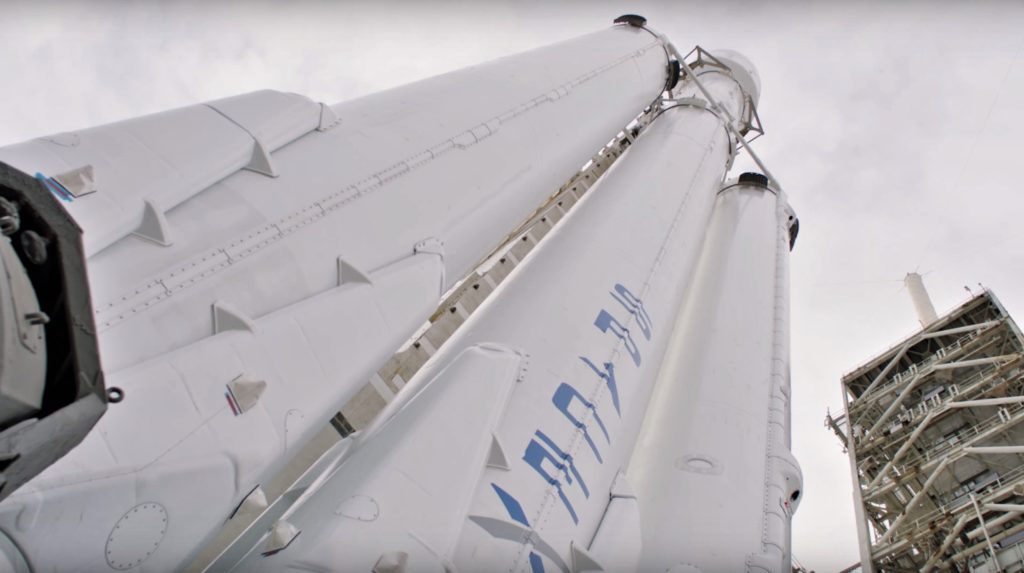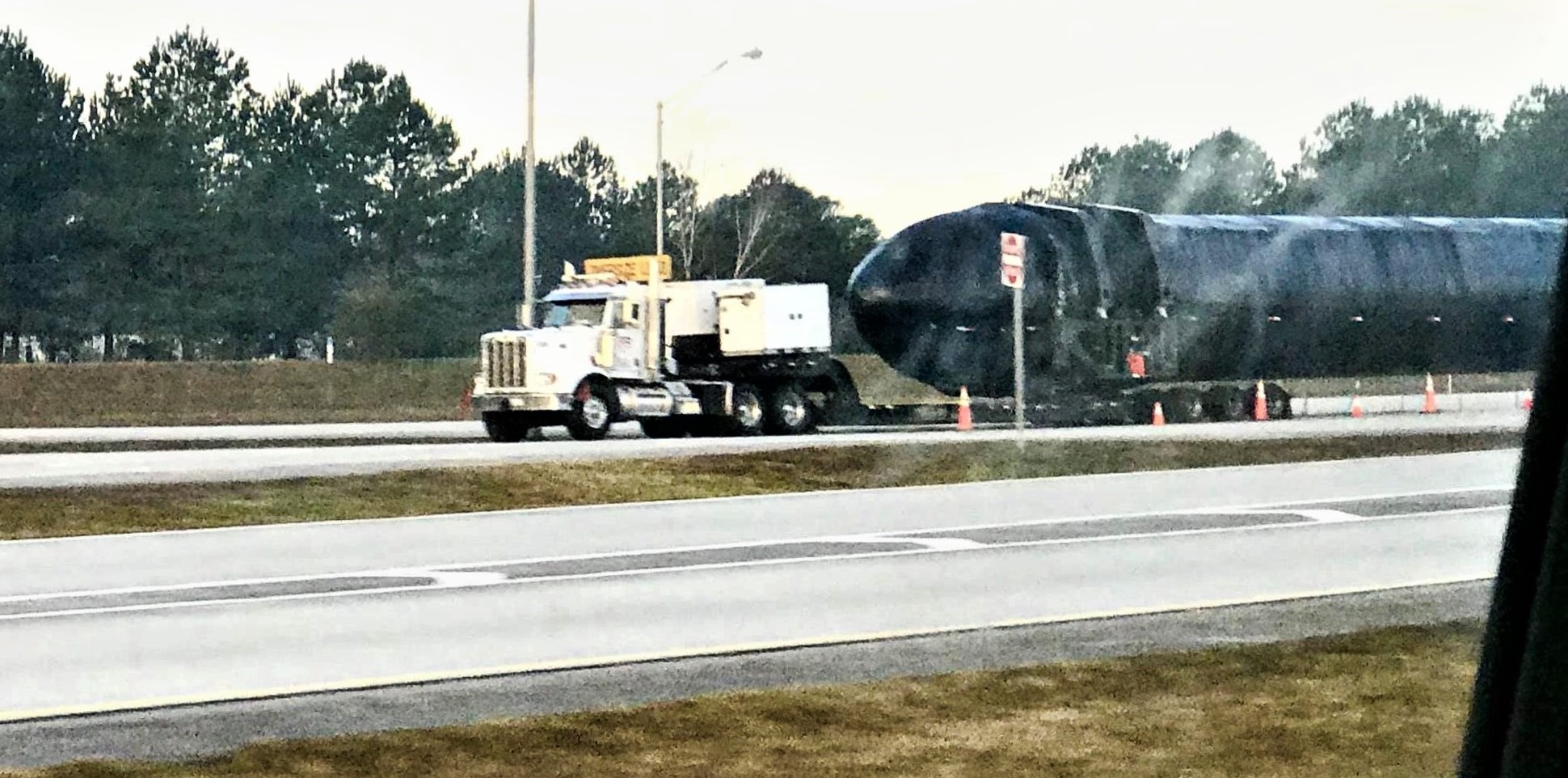
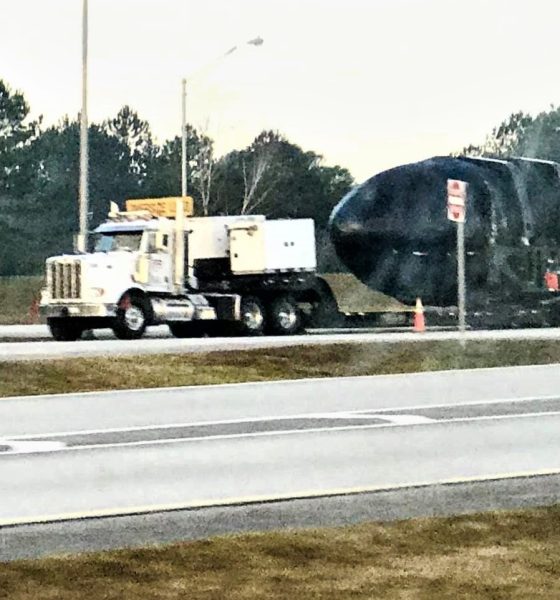
News
SpaceX’s second Falcon Heavy booster arrives in Florida as launch #2 closes in
SpaceX’s second Falcon Heavy side booster has made its way from Texas to Florida after completing a successful static fire acceptance test at the company’s McGregor complex, paving the way for the third and final booster – currently vertical on McGregor’s test stand – to complete its own round of tests and head East.
Once the third and most important booster – known as the center core – arrives at SpaceX’s Florida launch facilities, all three of the next Falcon Heavy’s boosters will be ready to head into the integration stage, culminating in an integrated static fire prior to the second launch ever of SpaceX’s flagship super-heavy-lift rocket.

A Texas pilot happened to fly by SpaceX’s McGregor facilities on January 11th, catching a live glimpse of a Merlin Vacuum (MVac) or second stage static fire test, as well a Falcon booster – perhaps Falcon Heavy’s next center core – vertical on the facility’s booster static fire stand. While it has not yet been visually confirmed as the next Falcon Heavy center core, a booster traveling through the Waco, Texas area to McGregor was spotted with protuberances that are not normally seen on regular Falcon 9 boosters and happened to be in the right place for FH-specific hardware.
- A booster – likely the next Falcon Heavy center core – was vertical at McGregor’s S1 static fire stand. (Instagram /u/tcryguy)
- An MVac or Falcon 9 S2 performs a static fire at McGregor. (Instagram /u/tcryguy)
There is also a case to be made that – per the fact that the first two side boosters have been built, shipped, tested, and delivered back-to-back – SpaceX chose to consecutively manufacture all hardware needed for the second Falcon Heavy instead of producing one or a few single-stick Falcon 9 boosters in between, which the appearance of a center core-like rocket in Texas certainly helps corroborate. While Falcon Heavy side boosters are effectively just Falcon 9 boosters with a few additional attachments and nose cones, currently scheduling indicates that SpaceX may attempt to rapidly turn all three Falcon Heavy Flight 2 boosters around perhaps just 30-60 days after their first launch. Otherwise, once the rocket’s 2019 launches have been completed, both side boosters can be converted back into Falcon 9 boosters and thus reenter SpaceX’s active fleet of flight-proven rockets.
Falcon Heavy’s center core, however, is dramatically different than a regular Falcon 9 booster, owing to the fact that it needs to essentially support triple the thrust and mechanical stresses as single-stick launches. The rocket’s design works to improve payload performance by using the two side cores to boost the center core and leave it with far more propellant left over than Falcon 9 would during a comparable launch profile, roughly equivalent to a three-person bike where only two people are pedaling hard. During a Falcon Heavy launch, side boosters thus separate a solid 30-60 seconds before the center core parts ways with the upper stage and payload.
- A diagram from a recent SpaceX document offers an idea of what Falcon Heavy Block 5 will look like. (SpaceX)
- The first Falcon Heavy, seen here fully integrated aside from its payload fairing. (SpaceX)
- Falcon Heavy just prior to its launch debut, February 2018. (Tom Cross)
- SpaceX’s Falcon Heavy prepares for the huge rocket’s inaugural launch. (SpaceX)
- LZ-1 and LZ-2, circa February 2018. (SpaceX)
Thanks to its significant differences, it’s highly unlikely – if not impossible – for a Falcon Heavy center core to launch a regular Falcon 9 mission. As such, once Falcon Heavy’s 2019 launches are completed, the center core will most likely be processed, refurbished, and then stored until the next Falcon Heavy payload is ready to go, at which point Falcon 9 boosters would be converted into Heavy side cores. Given that the Block 5 upgrade is designed to allow Falcon boosters to perform as many as 10 launches with minimal to no refurbishment and 100+ with regular repairs and maintenance, it’s entirely possible that a single Falcon Heavy center core could theoretically support all possible future launches of the rocket.
In reality, customers like the USAF and NASA will probably request new hardware for foreseeable Falcon Heavy launches, most of which would likely be extremely expensive flagship satellites (AFSPC-52) or interplanetary spacecraft (Europa Clipper).
Fans of @SpaceX will be interested to note that the government is now taking very seriously the possibility of flying Clipper on the Falcon Heavy.
— Eric Berger (@SciGuySpace) December 3, 2018
Falcon Heavy’s next two launches are planned as early as March (a large communications satellite called Arabsat 6A) and April (an experimental USAF launch called STP-2 with two dozen separate payloads). With two side boosters already in Florida, those dates are now serious possibilities, and the center core’s arrival will be the telltale sign that Falcon Heavy’s second launch ever is imminent.

Elon Musk
Elon Musk’s X will start using a Tesla-like software update strategy
The initiative seems designed to accelerate updates to the social media platform, while maintaining maximum transparency.

Elon Musk’s social media platform X will adopt a Tesla-esque approach to software updates for its algorithm.
The initiative seems designed to accelerate updates to the social media platform, while maintaining maximum transparency.
X’s updates to its updates
As per Musk in a post on X, the social media company will be making a new algorithm to determine what organic and advertising posts are recommended to users. These updates would then be repeated every four weeks.
“We will make the new 𝕏 algorithm, including all code used to determine what organic and advertising posts are recommended to users, open source in 7 days. This will be repeated every 4 weeks, with comprehensive developer notes, to help you understand what changed,” Musk wrote in his post.
The initiative somewhat mirrors Tesla’s over-the-air update model, where vehicle software is regularly refined and pushed to users with detailed release notes. This should allow users to better understand the details of X’s every update and foster a healthy feedback loop for the social media platform.
xAI and X
X, formerly Twitter, has been acquired by Elon Musk’s artificial intelligence startup, xAI last year. Since then, xAI has seen a rapid rise in valuation. Following the company’s the company’s upsized $20 billion Series E funding round, estimates now suggest that xAI is worth tens about $230 to $235 billion. That’s several times larger than Tesla when Elon Musk received his controversial 2018 CEO Performance Award.
As per xAI, the Series E funding round attracted a diverse group of investors, including Valor Equity Partners, Stepstone Group, Fidelity Management & Research Company, Qatar Investment Authority, MGX, and Baron Capital Group, among others. Strategic partners NVIDIA and Cisco Investments also continued support for building the world’s largest GPU clusters.
News
Tesla FSD Supervised wins MotorTrend’s Best Driver Assistance Award
The decision marks a notable reversal for the publication from prior years, with judges citing major real-world improvements that pushed Tesla’s latest FSD software ahead of every competing ADAS system.

Tesla’s Full Self-Driving (Supervised) system has been named the best driver-assistance technology on the market, earning top honors at the 2026 MotorTrend Best Tech Awards.
The decision marks a notable reversal for the publication from prior years, with judges citing major real-world improvements that pushed Tesla’s latest FSD software ahead of every competing ADAS system. And it wasn’t even close.
MotorTrend reverses course
MotorTrend awarded Tesla FSD (Supervised) its 2026 Best Tech Driver Assistance title after extensive testing of the latest v14 software. The publication acknowledged that it had previously criticized earlier versions of FSD for erratic behavior and near-miss incidents, ultimately favoring rivals such as GM’s Super Cruise in earlier evaluations.
According to MotorTrend, the newest iteration of FSD resolved many of those shortcomings. Testers said v14 showed far smoother behavior in complex urban scenarios, including unprotected left turns, traffic circles, emergency vehicles, and dense city streets. While the system still requires constant driver supervision, judges concluded that no other advanced driver-assistance system currently matches its breadth of capability.
Unlike rival systems that rely on combinations of cameras, radar, lidar, and mapped highways, Tesla’s FSD operates using a camera-only approach and is capable of driving on city streets, rural roads, and freeways. MotorTrend stated that pure utility, the ability to handle nearly all road types, ultimately separated FSD from competitors like Ford BlueCruise, GM Super Cruise, and BMW’s Highway Assistant.
High cost and high capability
MotorTrend also addressed FSD’s pricing, which remains significantly higher than rival systems. Tesla currently charges $8,000 for a one-time purchase or $99 per month for a subscription, compared with far lower upfront and subscription costs from other automakers. The publication noted that the premium is justified given FSD’s unmatched scope and continuous software evolution.
Safety remained a central focus of the evaluation. While testers reported collision-free operation over thousands of miles, they noted ongoing concerns around FSD’s configurable driving modes, including options that allow aggressive driving and speeds beyond posted limits. MotorTrend emphasized that, like all Level 2 systems, FSD still depends on a fully attentive human driver at all times.
Despite those caveats, the publication concluded that Tesla’s rapid software progress fundamentally reshaped the competitive landscape. For drivers seeking the most capable hands-on driver-assistance system available today, MotorTrend concluded Tesla FSD (Supervised) now stands alone at the top.
News
Elon Musk’s Grokipedia surges to 5.6M articles, almost 79% of English Wikipedia
The explosive growth marks a major milestone for the AI-powered online encyclopedia, which was launched by Elon Musk’s xAI just months ago.

Elon Musk’s Grokipedia has grown to an impressive 5,615,201 articles as of today, closing in on 79% of the English Wikipedia’s current total of 7,119,376 articles.
The explosive growth marks a major milestone for the AI-powered online encyclopedia, which was launched by Elon Musk’s xAI just months ago. Needless to say, it would only be a matter of time before Grokipedia exceeds English Wikipedia in sheer volume.
Grokipedia’s rapid growth
xAI’s vision for Grokipedia emphasizes neutrality, while Grok’s reasoning capabilities allow for fast drafting and fact-checking. When Elon Musk announced the initiative in late September 2025, he noted that Grokipedia would be an improvement to Wikipedia because it would be designed to avoid bias.
At the time, Musk noted that Grokipedia “is a necessary step towards the xAI goal of understanding the Universe.”
Grokipedia was launched in late October, and while xAI was careful to list it only as Version 0.1 at the time, the online encyclopedia immediately earned praise. Wikipedia co-founder Larry Sanger highlighted the project’s innovative approach, noting how it leverages AI to fill knowledge gaps and enable rapid updates. Netizens also observed how Grokipedia tends to present articles in a more objective manner compared to Wikipedia, which is edited by humans.
Elon Musk’s ambitious plans
With 5,615,201 total articles, Grokipedia has now grown to almost 79% of English Wikipedia’s article base. This is incredibly quick, though Grokipedia remains text-only for now. xAI, for its part, has now updated the online encyclopedia’s iteration to v0.2.
Elon Musk has shared bold ideas for Grokipedia, including sending a record of the entire knowledge base to space as part of xAI’s mission to preserve and expand human understanding. At some point, Musk stated that Grokipedia will be renamed to Encyclopedia Galactica, and it will be sent to the cosmos.
“When Grokipedia is good enough (long way to go), we will change the name to Encyclopedia Galactica. It will be an open source distillation of all knowledge, including audio, images and video. Join xAI to help build the sci-fi version of the Library of Alexandria!” Musk wrote, adding in a later post that “Copies will be etched in stone and sent to the Moon, Mars and beyond. This time, it will not be lost.”
